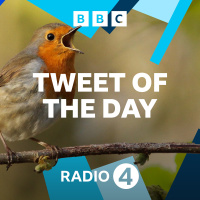Sinopsis
Discover birds through their songs and calls. Each Tweet of the Day begins with a call or song, followed by a story of fascinating ornithology inspired by the sound.
Episodios
-
Wild Turkey
27/11/2014 Duración: 01minTweet of the Day is the voice of birds and our relationship with them, from around the world.Chris Packham presents the wild turkey of North American woodlands. We are so used to seeing mass-produced captive turkeys (the centrepiece for many a Thanksgiving meal in the United States and Canada) that the sight and sound of a displaying male wild turkey is a real surprise. With his tail fanned and red wattles a-quiver; he struts-his-stuff in a woodland clearing to win the favours of the less flamboyant hens. There are now around 7 million wild turkeys in the USA. But it wasn't always so. Wild turkeys were nearly wiped out in many states by over-shooting and woodland clearance. Their numbers fell from tens of millions in pre-Columbus days, to about thirty thousand by the last Century. Land which had been previously cleared for farming was allowed to return to woodland. Wild turkeys were released back into areas where they'd been wiped out. This along with hunting controls and behavioural research allowed their nu
-
Great Snipe
26/11/2014 Duración: 01minTweet of the Day is the voice of birds and our relationship with them, from around the world. Chris Packham presents the superbly camouflaged great snipe of Eastern Europe. A thin drizzle of tinkling notes mingled with rhythmic tapping drifts across a Polish marsh in spring a sign that great male snipes are displaying. Great snipe are wading birds with short legs and very long two-toned bills, which they use to probe bogs and wet ground for worms. Across much of Europe having newly returned from its sub-Saharan wintering grounds a number of northern and eastern European marshes, set stage as breeding sites for the larger, great snipe. They court females at traditional lekking or displaying grounds where several males vie for attention. Perched on a small mound, males gather at sunset to fan their white outer tail feathers, puff out their chests and produce a medley of very un-wader-like calls. The females, looking for a mate, are attracted to the dominant males at the centre of the lek.Producer : Andrew Daw
-
Flightless Cormorant
25/11/2014 Duración: 01minTweet of the Day is the voice of birds and our relationship with them, from around the world. Chris Packham presents the flightless cormorant adapted to its Galapagos world. The isolated Galapagos Islands are famous for their unique wildlife which has evolved to adapt to a landscape free of predators. This absence of predators has allowed the native cormorant to dispense with the need to fly, why waste energy when there's nothing to fly away from? This is the only flightless member of the cormorant family, which feeds on fish and for that reason it has developed stronger feet for swimming after its prey. They nest on the rocky coasts of Fernandina and Isabela islands and the population can dip below a thousand birds especially after hurricanes or collapses in local fish numbers. They recover quickly though, but are vulnerable to introduced dogs which nearly eliminated the cormorants on Isabela Island.
-
Red-billed Tropicbird
24/11/2014 Duración: 01minTweet of the Day is the voice of birds and our relationship with them, from around the world. Chris Packham presents a true global ocean going mariner, the red-billed tropicbird. These elegant birds are masters of the winds and tides. There are three species of tropicbirds and all of them nest on tropical islands, spending the rest of the year roaming the open ocean. All are instantly recognisable by their very long whippy central tail-feathers which can be longer than the rest of the bird. With scarlet beaks, black wing-tips and white-tail streamers from a distance they look all-white, but a closer view reveals a narrow black mask. Red-billed Tropicbirds nest on the ground and use their impossibly long tails in courtship displays, moving the feathers to register excitement or aggression. In flight they are graceful soarers and swoopers, and often call a trill chattering rattle in mid-air chases. This sound which resembles a bosun's (boatswain's) whistle, gave rise to their alternative name of 'Bosun Bird'.
-
Ivory Gull
21/11/2014 Duración: 01minTweet of the Day is the voice of birds and our relationship with them, from around the world. Chris Packham presents the ivory gull from the northern polar seas. Ivory gulls breed on rocky outcrops and cliffs and has a near-circumpolar distribution, spending most of the year near the edge of the pack ice throughout Arctic Europe, Arctic Russia, Greenland and Canada. They regularly venture farther north than any other bird. The adults are brilliant white with black legs and black eyes; their only splash of colour is on the bill which is a pastel rainbow of blue, green, yellow and pink. At rest they look rather dove-like. Although their colour suggests purity, their tastes are definitely not. Ivory gulls are scavengers. Dead seals or whales will draw them from miles around and those birds which have turned up as rare winter visitors to the UK have often shown an uncanny ability to locate strandline corpses of porpoises, dolphins or seals. Diet aside these are entrancing gulls to watch as they loaf on icebergs
-
Purple Martin
20/11/2014 Duración: 01minTweet of the Day is the voice of birds and our relationship with them, from around the world. Chris Packham presents the purple martin from eastern North America. Every spring, across the land from Chicago to St Louis, you can hear couples squabbling over the best real estate. But these aren't human house-buyers, they're purple martins. Purple Martins are the largest North American swallow, glossy blue-black rather than purple and much chunkier than the well-known barn swallow. They spend the winter in insect-rich places in South America and return to their North American breeding colonies each spring. In the west, they nest in holes in trees or even in giant saguaro cacti, but in the east where they're much more common, they almost exclusively rely on people to provide them with nest-sites. Visit almost any city, town or homestead and you'll see multi-story nest-boxes, the home of a score of purple martin families. Around 1 million people are thought to erect housing each year. Their human landlords take
-
Asian Crested Ibis
19/11/2014 Duración: 01minTweet of the Day is the voice of birds and our relationship with them, from around the world. Chris Packham presents the rare Asian crested Ibis formerly common in Japan and China. The crested ibis is mainly white with a shaggy white crest and a red face; but in the breeding season its plumage is tinged with ash-grey. Under its wings is a subtle peach tone, a colour known in Japan as toki-iro. Unfortunately its beauty hasn't saved the crested ibis from persecution in Japan, China or Siberia where it used to breed. It was thought to be extinct in China, until seven birds were found in 1981. In 2003 the crested ibis became extinct in the wild in Japan. Now, crested ibis are conservation symbols in the Far East. They are strictly protected in China where they are being reintroduced to increase the small wild population. In Japan the first wild Japanese crested ibis chick flew from its nest in 2012.
-
Rhinoceros Auklet
18/11/2014 Duración: 01minTweet of the Day is the voice of birds and our relationship with them, from around the world. Chris Packham presents the rhinoceros auklet found around the North American western seaboard. Rhinoceros auklets are auks. They look very different to their relatives the puffins or guillemots. They're dark grey-ish brown birds, and in the breeding season both male and female have flowing white plumes above their eyes and behind their orange bills. It is the white vertical plate at the base of its bill which has inspired the birds' common names of "horn-billed puffins" or "unicorn puffins". This horn is only grown in the breeding season; the birds shed it in autumn when they head out to sea. Rhinoceros auklets in burrows or cavities in grassy places or on forest floors: most colonies are small, but some contain a hundred thousand birds which produce a soothing chorus of mooing and grunting sounds, strange to hear in the blackness of a coastal wood.Producer : Andrew Dawes
-
Arabian Babbler
17/11/2014 Duración: 01minTweet of the Day is the voice of birds and our relationship with them, from around the world. Chris Packham presents the Arabian babbler of a Yemeni Desert. Arabian babblers could almost be described as feathered meerkats. They're sociable, charismatic and always on the alert. These energetic and curious birds are found around the Arabian peninsula and in Egypt, often in dry scrubby places. They have long tails, curved bills and a bounding gait, and their sandy plumage is superb camouflage against the parched ground where they roam in search of insects and seeds. If on their travels, a group of babblers discovers a snake they will mob it with loud shrieks, raising their wings and calling to each other until they see it off. Arabian babblers don't use their social skills just to chase away predators. They spend all their time in groups of usually four to six adult birds and in these groups their relationships are fluid. They are also co-operative breeders and help each other to rear their chicks, a communa
-
Bell Miner
14/11/2014 Duración: 01minTweet of the Day is the voice of birds and our relationship with them, from around the world.Chris Packham presents the bell miner of eastern Australia. The sound of a tiny hammer striking a musical anvil in a grove of gum trees signifies that bell miners are in search of sugar. More often heard than seen the bell miner is a smallish olive-green bird with a short yellow bill, with a small orange patch behind the eye. It belongs to a large family of birds known as honeyeaters because many have a sweet tooth and use their long bills to probe flowers for nectar. But the bell miner gets its sugar hit in other ways. Roving in sociable flocks, bell miners scour eucalyptus leaves for tiny bugs called psyllids who produce a protective waxy dome. Bell miners feed on these sweet tasting shelters. Some scientists suggest that Bell Miners actively farm these insects by avoiding over-exploiting of the psyllid colonies, allowing the insects numbers to recover before the birds' next visit. So dependent are they on these psy
-
Plumbeous Antbird
13/11/2014 Duración: 01minTweet of the Day is the voice of birds and our relationship with them, from around the world.Chris Packham presents the Plumbeous antbird in a Bolivian rainforest. When army ants go on the march in the Bolivian rainforest, they attract a huge retinue of followers; often heard but rarely seen. These include Antbirds. The Plumbeous Antbird is a lead-coloured bird; the males have a patch of blue skin around their eyes, whilst the females are bright russet below. Like other antbirds they are supreme skulkers, hiding under curtains of dense foliage and only betraying themselves by their calls and song, a particularly fluty call. But you'd think that with a name like antbirds, their diet is easily diagnosed, but surprisingly antbirds rarely eat ants. Instead, most species shadow the columns of army ants which often change nest-sites or raid other ant colonies. As the ants march across the forest floor, they flush insects and other invertebrates which are quickly snapped by the attendant antbirds.Producer : Andrew D
-
Common Indian Cuckoo
12/11/2014 Duración: 01minTweet of the Day is the voice of birds and our relationship with them, from around the world. Chris Packham presents the Indian cuckoo found across much of South East Asia. A bird singing "crossword puzzle" - "crossword puzzle" over the woods is an Indian Cuckoo, a shy and slender bird, grey above and barred black and white below. These features are similar to those of a small hawk and when a cuckoo flies across a woodland glade, it's often mobbed by other birds. They're right to sense danger. Indian cuckoos are brood parasites and the females lay their eggs in the nests of other species including drongos, magpies and shrikes. The Indian cuckoo's song is well-known in the Indian sub-Continent and has been interpreted in different ways. As well as "crossword puzzle " some think it's saying "one more bottle" or "orange pekoe". And in the Kangra valley in northern India, the call is said to be the soul of a dead shepherd asking "... where is my sheep? Where is my sheep?".
-
Southern Cassowary
11/11/2014 Duración: 01minTweet of the Day is the voice of birds and our relationship with them, from around the world. Chris Packham presents the roaring southern cassowary of Australia's Queensland. The territorial roaring calls of the world's second heaviest bird, the cassowary are odd enough, but it still won't prepare you for your first sighting of these extraordinary birds. Reaching a height of over 1.5 metres, they have thick legs armed with ferocious claws, blue – skinned faces and scarlet dangling neck- wattles. These are striking enough but it is the large horn, or casque, looking like a blunt shark's fin on the bird's head that really stands out. It's earned this giant its common name - cassowary comes from the Papuan for "horned head". Such a primitive looking creature seems out of place in the modern world and although the southern cassowary occurs widely in New Guinea, it's still hunted for food there. Cassowaries can kill dogs and injure people with their stout claws, but the bird usually comes off worst in confrontat
-
Vegetarian Tree Finch
10/11/2014 Duración: 01minTweet of the Day is the voice of birds and our relationship with them, from around the world. Chris Packham presents the vegetarian tree finch on the Galapagos Islands. These streaky sparrow-like birds found on the Galapagos Islands may look rather plain, but belong to the evolutionary elite, having attracted the attention of Charles Darwin on his visit there in 1835. Darwin noticed that the fourteen or so species of finches, which he concluded were derived from a common ancestor on this isolate archipelago, had evolved bills adapted to the type of food available. The Vegetarian finch has a bill rather like a parrot's, with thick curved mandibles and a biting tip which also allows it to manipulate seeds, similar to a parrot or budgie. Vegetarian finches are especially fond of the sugar-rich twigs of certain shrubs and are use the biting tip of their bills to strip off the bark to reach the softer sweeter tissues beneath: a niche that other finches on Galapagos haven't exploited yet.Producer : Andrew Dawes
-
Blue Jay
07/11/2014 Duración: 01minTweet of the Day is the voice of birds and our relationship with them, from around the world. Chris Packham presents the North American blue jay. The loud warning screams of blue jays are just part of their extensive vocabulary. These birds are intelligent mimics. Blue jays are neat handsome birds; lavender-blue above and greyish below with a perky blue crest, black collar and white face. But the blue jay is not blue, but black. Its feather barbs contain a dark layer of melanin pigment; the blue we see is caused by light scattering through modified cells on the surface of the feather barbs and reflected back as blue. Common over much of eastern and central North America, blue jays will move in loose flocks to take advantage of autumnal tree mast. A single blue jay can collect and bury thousands of beechnuts, hickory nuts and acorns (in a behaviour known as caching) returning later in the year to retrieve these buried nuts. Any they fail to find, assist in the natural regeneration of native woodlands.Produ
-
North Island Kokako
06/11/2014 Duración: 01minTweet of the Day is the voice of birds and our relationship with them, from around the world. Chris Packham presents the North Island kokako from New Zealand. Kokakos are bluish-grey, crow-sized birds with black masks. Those from the North Island sport bright blue fleshy lobes called wattles; one on each side of the bill. And they are famous in New Zealand for their beautiful haunting song which males and females sing, often in a long duet in the early morning.Known by some people as the squirrel of the woods because of their large tails and habit of running along branches, kokako used to be widespread, today fewer than 1000 pairs remain. The kokako's slow and deliberate, almost thoughtful, flute-like song evokes the islands' forests and in the film, The Piano, it features as part of the chorus of woodland birds in some of the most atmospheric scenes.Producer : Andrew Dawes
-
Red-breasted Goose
05/11/2014 Duración: 01minTweet of the Day is the voice of birds and our relationship with them, from around the world. Chris Packham presents the red-breasted goose in Siberia. Red-breasted geese are colourful birds with art-deco markings of brick-red, black and white. Despite their dainty and somewhat exotic appearance, these are hardy birds which breed in the remotest areas of arctic Siberia. They often set up home near the eyries of birds of prey, especially peregrine falcons. But there's method in the madness; These wildfowl nest on the ground where their eggs and chicks are vulnerable to predators such as Arctic foxes. But the ever vigilant peregrine falcons detecting a predator, will defend their eyries by calling and dive-bombing any intruders, and this also doubles as a warning system for the geese. In winter red-breasted geese migrate south where most of them graze on seeds and grasses at a few traditional sites in eastern Europe around the Black Sea.Producer : Andrew Dawes
-
New Zealand Bellbird
04/11/2014 Duración: 01minTweet of the Day is the voice of birds and our relationship with them, from around the world.Chris Packham presents the New Zealand bellbird. In 1770, during Captain James Cook's first voyage to New Zealand, an extraordinary dawn chorus caught the attention of his crew "like small bells exquisitely tuned": these were New Zealand bellbirds. New Zealand bellbirds are olive green birds with curved black bills and brush-like tongues which they use to probe flowers for nectar. Like other honeyeaters, they play an important role in pollinating flowers and also eat the fruits which result from those pollinations and so help to spread the seeds. The well camouflaged bellbird is more often heard before it is seen. They sing throughout the day, but at their best at dawn or dusk when pairs duet or several birds chorus together. Their song can vary remarkably, and it is possible to hear different 'accents' in different parts of New Zealand, even across relatively short distances.Producer : Andrew Dawes
-
Toco Tucan
03/11/2014 Duración: 01minChris Packham presents the South American toco tucan. Few of us are lucky enough to have seen or heard a Toco Toucan at home in its South American strongholds but its image will be familiar to drinkers of a certain age. Its pied plumage and sky-blue eye-rings are striking enough but it is the toco toucan's huge black-tipped orange bill that makes the bird instantly recognisable. Despite appearances this cumbersome-looking banana-shaped bill is really quite light. Under the colourful plates which cover the bill a matrix of horny fibres and air-pockets combines strength with lightness a formula which has caught the attention of light aircraft manufacturers . The bird's massive bills were prominent in advertisements for a well-known brand of Irish stout beer in the 1930s and 40s. In various poses, often with a pint pot perched precariously on its bill, toucan's, extolled the virtues of beer-drinking.Producer : Andrew Dawes
-
Vampire Finch
31/10/2014 Duración: 01minTweet of the Day is the voice of birds and our relationship with them, from around the world.Miranda Krestovnikoff presents the blood sucking vampire finch. On Wolf Island in the remote Galapagos archipelago, a small dark finch sidles up to a booby with a taste for blood. Sharp-beaked ground finch is found on several islands in the Galapagos and is one of the family known as Darwin's finches. Several species of ground-finches have devolved bill sizes which vary depending on their diet and the competition for food. Usually seeds, fruits, nectar and grubs. But one sharp-beaked ground-finch has gorier ambitions. On the isolated islands of Wolf and Darwin where seeds are scarcer in times of drought this bird has taken to drinking the blood of other seabirds, especially boobies. It pecks at the bases of their feathers and greedily laps up the flowing blood. For this reason it's often known as the, the vampire finch.Producer : Andrew Dawes














